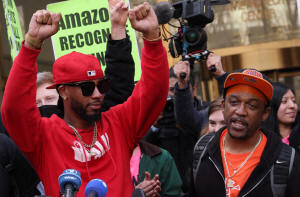Amazon issued 13,000 disciplinary notices at single U.S. warehouse
 Send a link to a friend
Send a link to a friend
 [July 12, 2022]
(Note: This story has strong language in paragraph 28) [July 12, 2022]
(Note: This story has strong language in paragraph 28)
By Jeffrey Dastin
NEW YORK (Reuters) - Amazon worker Gerald
Bryson had hand-counted thousands of items in his warehouse's inventory
over three days when his manager showed him a "Supportive Feedback
Document."
Bryson had made 22 errors, the 2018 write-up said, including tallying 19
products in a storage bin that in fact had 20. If Bryson erred like this
six times within a year, the notice stated, he would be fired from the
Staten Island warehouse, one of Amazon.com Inc’s largest in the United
States.
Internal Amazon documents, previously unreported, reveal how routinely
the company measured workers’ performance in minute detail and
admonished those who fell even slightly short of expectations -
sometimes before their shift ended. In a single year ending April 2020,
the company issued more than 13,000 so-called “disciplines” in Bryson’s
warehouse alone, one lawyer for Amazon said in court papers. The
facility had about 5,300 employees around that time.
The records and interviews of current and former employees show the
enormous pressure faced by Amazon line workers to complete tasks as
accurately and quickly as the company demands - creating an environment
that some workers told Reuters has fueled unionization efforts around
the country. In March, Bryson’s workplace voted to become Amazon’s first
organized warehouse in the United States, and staff from more than 100
other facilities nationwide are striving to follow suit, according to
the Amazon Labor Union, an independent labor group formed in April 2021.

Amazon, the largest online retailer in the United States, disclosed
these records in response to a complaint by the National Labor Relations
Board (NLRB) over Bryson’s dismissal in April 2020. Many of these
documents also were contained in a separate and ongoing federal court
lawsuit in which the NLRB sought to stop what it called Amazon’s
“flagrant unfair labor practices” - actions the company denied in court
papers.
In a statement, Amazon said the goals it sets are “fair and based on
what the majority of the team is actually accomplishing.” The company
says it delivers more praise to workers than criticism. “We give a lot
of feedback to employees throughout the year to help them succeed and
make sure they understand expectations,” Amazon said.
Kathy Drew King, regional director of the NLRB's Brooklyn office, said
the board “has vigorously sought” Amazon’s compliance with labor law.
An administrative law judge this April ordered Bryson’s reinstatement
after finding the retailer had fired him illegally for protesting
workplace safety conditions. Amazon is appealing the judge’s decision,
saying in a statement that the company terminated Bryson for defaming a
colleague during a demonstration in the warehouse’s parking lot. Bryson
said the employee had verbally attacked him.
Bryson, now a union organizer, added that he isn't sure he’ll return.
“If I walk back through those doors, it’s going to show the workers that
they can fight,” he said.
OFF TASK FOR SIX MINUTES
Amazon told the judge in Bryson’s case that it could not meet NLRB
demands in a subpoena to provide the thousands of disciplinary notices
it delivered to employees that year, calling the requirement “unduly
burdensome.”
However, it provided statistics for what it called “disciplines” - which
include firings, suspensions and warnings - at three warehouses, and it
turned over scores of personnel files. These included more than 600
notices for workers between 2015 and 2021 that were positive, negative
or neutral. It is not clear from the records whether the notices were a
representative sample of the company’s feedback. Also in the records
were worker affidavits and email exchanges between Amazon and government
lawyers.

Among the documented violations for which Amazon faulted employees:
* Being off task for six minutes in June 2018, resulting in a reprimand
that a Carteret, New Jersey, warehouse worker received at 2:57 a.m.
during the same shift.
* Meeting 94% of the company’s productivity goal
instead of 100%. For weeks, a worker at the same New Jersey warehouse
had surpassed expectations. But Amazon management warned him in October
2017 about possible termination if he didn’t improve his rate of
scanning and verifying items, which dipped to 164 per hour, below the
target of about 175.
* Exceeding break time by four minutes. Although Amazon offers a “5
minute walking grace” period for breaks, the same New Jersey worker who
was dinged for productivity also received a write-up in March 2017
telling him not to exceed the time limit.
* Making four errors grabbing items shoppers ordered in a single spring
2019 week, during which a New York City warehouse worker picked more
than 15,800 goods correctly for customers.
[to top of second column]
|

Amazon Labour Union (ALU) organizer Gerald Bryson speaks to the
media as ALU members celebrate official victory after hearing
results regarding the vote to unionize, outside the NLRB offices in
Brooklyn, New York City, U.S., April 1, 2022. REUTERS/Brendan
McDermid

In its statement, Amazon said these write-ups did not accurately
reflect its current policies. In a June 2021 blog post, the company
said it began averaging workers’ “time off task” - periods of
inactivity - over a longer period before engaging with employees. It
did not specify how the period was extended. Amazon acknowledged
that some managers had incorrectly resorted to discipline rather
than “coaching” workers.
According to Amazon’s statement to Reuters, less than 25% of
feedback is about what it called “opportunities for improvement,”
and the majority of that relates to attendance, such as when an
employee risks exceeding allotted time off.
Without full records of company notices, Reuters was unable to
verify those figures.
However, the raw numbers of “disciplines” cited by Amazon itself in
court papers suggested they were prolific. Management for a
warehouse in Robbinsville, New Jersey, with an average of about
4,200 workers as of Dec. 2020, gave employees more than 15,000
disciplines in the year leading to April 2020, the lawyer for Amazon
wrote. A North Haven, Connecticut, warehouse, with an average 4,800
workers as of December 2020, issued more than 5,000 such notices in
the year ending in April 2020. Some individual employees received
numerous disciplinary notices.
WALKING LIKE HE’S ‘1,000 YEARS OLD’
A stack of critical notices dogged Bryson despite what he described
as his best efforts to meet Amazon’s standards. He joined the Staten
Island warehouse shortly after it opened in 2018, with starting pay
of $16.50 an hour. His job was to count bin after bin of screws,
bolts and other inventory using a gun-shaped scanner.
After first being warned in writing about mistakes, Bryson said he
slowed down to get the count right. On Dec. 6 that year, he was
faulted for tallying 295 goods per hour, when the company expected
478. He told Reuters that he tried going twice as fast to make up
for a sluggish day and agonized at his kitchen table over whether
his performance had sufficed.

"You're sitting there worried about whether you're going to have a
job tomorrow because your rate is not where it's supposed to be,"
recalled Bryson, now 59. "It was horrible."
He got two more write-ups that month even as he picked up speed to
an hourly rate of 371, the Amazon documents show. Bryson said he
just kept "counting and moving and counting and moving,” and was
slapped again with write-ups for errors. Ultimately, he blazed
through nearly 8,000 items over four days in January 2019 – fast and
accurate enough to clinch Amazon's praise.
"Your recent job performance has met or exceeded Productivity
expectations," he was advised.
But his feet swelled and his body ached, Bryson said, adding that
just walking from his car after work to his apartment made him feel
as though he were “1,000 years old.”
Workers in recent years have flocked to the giant retailer for wages
generally higher than its biggest rivals'. Last September, to hire
in a tight labor market, Amazon said it raised its average starting
salary for U.S. operations staff to more than $18 an hour, about 10%
more than the average salary then offered by Walmart, the country’s
largest private employer.
But the work took an emotional toll, at least two employees said in
the court records. Roshawn Heslop, a ship dock employee in North
Haven, said stress led him to lash out in November 2019 after a
manager confronted him for leaving his post. "I'm doing my f*cking
job," Heslop said, according to a human resources summary of the
incident. According to HR records, the manager was skeptical of
Heslop’s explanation that he had gone to get a tool.
According to HR records, Heslop said he was usually "a quiet guy"
who's "here to work" and occasionally takes walks because of a
health condition. The manager emailed HR three times encouraging the
company to discipline Heslop for vulgar language, which the company
eventually did. He was placed on probation, with the possibility of
termination if he did not measure up.
Amazon said write-ups like that are uncommon, but “it’s important to
treat each other with respect, and we do not tolerate, at any level,
inappropriate behavior.”
Heslop, 28, who still works for Amazon, says the company itself
doesn’t respect workers like him.
“It doesn’t matter how much I work or how good I work,” he said.
“It’s a game you can’t win.”
(Reporting by Jeffrey Dastin in New York; additonal reporting by
Jonathan Stempel; editing by Anna Driver and Julie Marquis)
[© 2022 Thomson Reuters. All rights
reserved.]
This material may not be published,
broadcast, rewritten or redistributed.
Thompson Reuters is solely responsible for this content. |